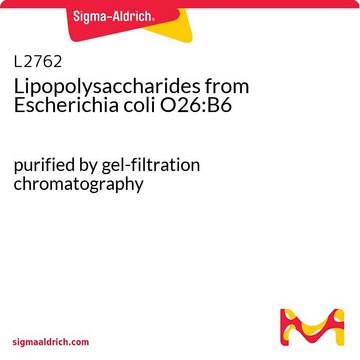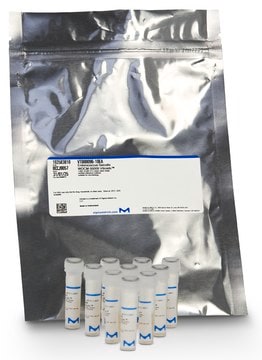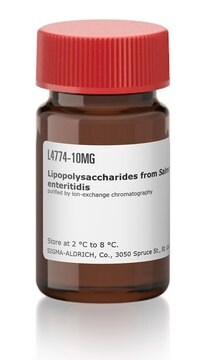L4268
Lipopolysaccharides from Klebsiella pneumoniae
purified by phenol extraction
Synonym(s):
LPS
Sign Into View Organizational & Contract Pricing
All Photos(3)
About This Item
Recommended Products
biological source
bacterial (Klebsiella pneumoniae)
Quality Level
form
lyophilized powder
purified by
phenol extraction
impurities
<3% Protein (Lowry)
color
white to faint yellow
solubility
water: 4.90-5.10 mg/mL, slightly hazy to turbid, colorless to faintly yellow
shipped in
ambient
storage temp.
2-8°C
Looking for similar products? Visit Product Comparison Guide
General description
This product is phenol extracted from Klebsiella pneumoniae. The source strain is ATCC 15380.
Biochem/physiol Actions
Lipopolysaccharides (LPS) are localized in the outer layer of the membrane and are, in noncapsulated strains, exposed on the cell surface. They contribute to the integrity of the outer membrane, and protect the cell against the action of bile salts and lipophilic antibiotics.
Preparation Note
The product is soluble in water (5 mg/ml) or cell culture medium (1 mg/ml) yielding a hazy, faint yellow solution. A more concentrated, though still hazy, solution (20 mg/ml) has been achieved in aqueous saline after vortexing and warming to 70-80 oC. Lipopolysaccharides are molecules that form micelles in every solvent. Hazy solutions are observed in water and phosphate buffered saline. Organic solvents do not give clearer solutions. Methanol yields a turbid suspension with floaters, while water yields a homogeneously hazy solution.
Other Notes
To gain a comprehensive understanding of our extensive range of Lipopolysaccharides for your research, we encourage you to visit our Carbohydrates Category page.
Storage Class Code
11 - Combustible Solids
WGK
WGK 3
Flash Point(F)
Not applicable
Flash Point(C)
Not applicable
Personal Protective Equipment
dust mask type N95 (US), Eyeshields, Gloves
Choose from one of the most recent versions:
Already Own This Product?
Find documentation for the products that you have recently purchased in the Document Library.
Customers Also Viewed
Teresa García-Lezana et al.
Journal of cerebral blood flow and metabolism : official journal of the International Society of Cerebral Blood Flow and Metabolism, 37(3), 927-937 (2016-05-08)
Hepatic encephalopathy has traditionally been considered a reversible disorder. However, recent studies suggested that repeated episodes of hepatic encephalopathy cause persistent impairment leading to neuronal loss. The aims of our study were the development of a new animal model that
Jinling Zhang et al.
Biosensors & bioelectronics, 99, 312-317 (2017-08-09)
We report a smartphone label-free biosensor platform based on grating-coupled surface plasmon resonance (GC-SPR). The sensor system relies on the smartphone's built-in flash light source and camera, a disposable sensor chip with Au diffraction grating and a compact disk (CD)
Nora S Wolff et al.
Intensive care medicine experimental, 8(1), 47-47 (2020-08-26)
The microbiome has emerged as an important player in the pathophysiology of a whole spectrum of diseases that affect the critically ill. We hypothesized that differences in microbiota composition across vendors can influence murine models of pulmonary lipopolysaccharide (LPS) inflammation
Christian Maueröder et al.
Frontiers in immunology, 7, 583-583 (2016-12-27)
In this study, we identified and characterized the potential of a high ratio of bicarbonate to CO2 and a moderately alkaline pH to render neutrophils prone to undergo neutrophil extracellular trap (NET) formation. Both experimental settings increased the rate of
C Arnold Spek et al.
Cells, 10(9) (2021-09-29)
CCAAT/enhancer-binding protein delta (C/EBPδ) is a member of the C/EBP family of transcription factors. According to the current paradigm, C/EBPδ potentiates cytokine production and modulates macrophage function thereby enhancing the inflammatory response. Remarkably, however, C/EBPδ deficiency does not consistently lead
Our team of scientists has experience in all areas of research including Life Science, Material Science, Chemical Synthesis, Chromatography, Analytical and many others.
Contact Technical Service


